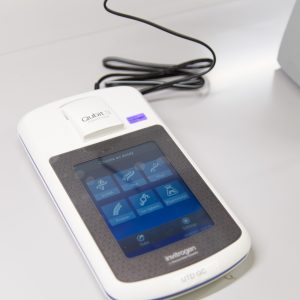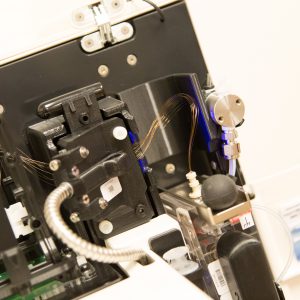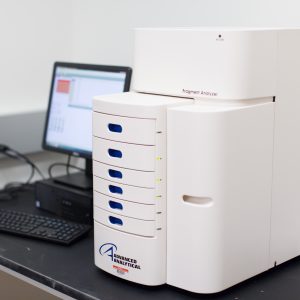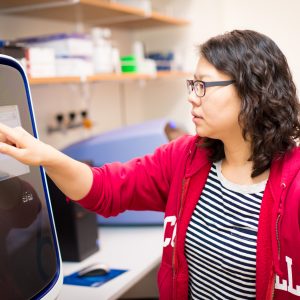The UTD Genome Center offers a high level of expertise in next generation sequencing technology to support research at UTD and across North Dallas area. We provide sample QC, library preparation and sequencing service for Next Generation Sequencing using Nextseq 500 sequencer. We are equipped with the state-of-art instruments for preparing high quality of samples for NGS including Fragment analyzer, Qubit 3.0 Fluorometer, and QuantStudio 6. In addition, Fluidigm C1 system and 10x Genomics Chromium controller are available for single-cell sequencing. QuantStudio 6 offers a 384-well block format for multiplexing PCR.
*Updates effective on 1/12/2023
- Illumina Nextseq 2000 now can sequence up to 600 bp
- GC has acquired 10x Genomics Chromium X, which allows fixed RNA profiling
Instruments

- Illumina Nextseq 2000 is the most cost-effective sequencing platform. The newer model of Nextseq uses patterned flowcells and Illumina’s ExAmp clustering chemistry, which requires more stringent quality control. Nextseq 2000 offers broader options for data output and sequencing read length; P1 flowcells offers the smallest data output, similar to Nextseq 500 Mid-output. P2 flowcells produce a similar number of reads when compared to Nextseq 500 High-output. P3 flowcells have physically larger sequencing lanes than P1/P2 flowcells, which allows producing more than 2.5 times more data than Nextseq 500 High-output. We will utilize BaseSpace Cloud for convenient data transfer.

- AATI Fragment Analyzer is an automated capillary-electrophoresis instrument. It resolves double-stranded nucleotide, RNA, and genomic DNA from 10 bp to 40,000 bp with a resolution of 3 bp for fragments. The Fragment analyzer offers a high sensitivity with lowest detecting concentration at 5 pg/ul.

- Fluidigm C1 prepares single cells templates for mRNA and DNA sequencing, miRNA expression or epigenetics. This instrument separates and captures single cells into an individual reaction chambers in the exclusive Fluidigm integrated fluidic circuit (IFC). The optically clear IFC enables automatically stain the captured cells and exam them by microscopy for viability, surface markers, or reporter genes. After staining, the cells will be lysed and template is quickly prepared for qPCR or sequencing analysis.
- Lifetechnology QuantStudio 6 is a quantitative PCR machine with interchangeable blocks of 96-well fast and 384-well. Although the instrument is mainly for the Center service use, it is offered to GC users for their need of multiple applications upon initial consultation.

- Qubit 3.0 Fluorometer offers an accurate measurement of DNA and RNA concentration based on highly sensitive fluorescence quantification assays. The fluorescent dyes used in the assays emit signals only when bound on specific target molecules, which gives a far more accurate measurement than UV-based quantification.
- 10x Genomics Chromium X can perform any 10x Genomics single cell assay with the throughput flexibility of 100s to 100,000s of cells per run. This instrument allows to use fixed cells for single cell RNA sequencing.
- Applied Biosystems SeqStudio Genetic analyzer is a low-throughput, user-friendly benchtop system that performs Sanger sequencing or fragment analysis. A cartridge-based system allows you to use only what you need, without sharing experimental reagents, and to avoid unnecessary waste. The unique cartridge design enables multiple users to share a single SeqStudio Genetic Analyzer. Without complex setup, you will be ready to go in minutes.
For instrument reservations, see the Lab Resources Scheduler.
Service and Rates
*Rate Increase effective on 03/01/2023
For UTD users, please login to view UTD rates.
Sample QC service
| Types | Academic | Industry | Note |
|---|---|---|---|
| Qubit | $2.85 | $3.25 | Per sample |
| Fragment analyzer | $7 | $7.8 | Per sample, min. 6 samples |
| qPCR quantification | $63.25 | $71.50 | Per run, max. 12 samples per run |
Library preparation
| Types | Unit | Academic | Industry |
|---|---|---|---|
| Stranded total RNA +rRNA removal (Eukaryotic) | per sample | $236 | $267 |
| Stranded total RNA + rRNA removal (Bacterial) | per sample | $249 | $281 |
| Stranded mRNA | per sample | $183 | $207 |
| gDNA* | per sample | $145 | $164 |
| 10x Chromium single cell 3’ library | per sample | $2,422 | $2,738 |
| 10x Fixed RNA profiling (2-4 samples/rxn) | per reaction | $6,917 | $7,820 |
| 10x Fixed RNA profiling (5-16 samples/rxn) | per reaction | $11,000 | $12,435 |
Sequencing service ($ per run)
Nextseq 2000
| Flow cell type | Read length | Academic | Industry |
|---|---|---|---|
| P1 | 100 bp | $1,196 | $1,352 |
| 300 bp | $1,743 | $1,971 | |
| 600 bp | $2,732 | $3,089 | |
| P2 | 100 bp | $1,884 | $2,129 |
| 200 bp | $3,486 | $3,940 | |
| 300 bp | $4,640 | $5,246 | |
| 600 bp | $5,251 | $5,936 | |
| P3 | 50 bp | $2,829 | $3,198 |
| 100 bp | $4,137 | $4,676 | |
| 200 bp | $5,836 | $6,598 | |
| 300 bp | $7,845 | $8,869 | |
| Sanger sequencing (price per sample) | $10.00 | $15.00 | |
Sample Submission Guideline
- We would recommend submitting aliquots of your samples.
a. NGS Libraries prepared by you
- Submit libraries at 10-20 nM in a volume of at least 10ul.
- Submit index information of your libraries and how your libraries were made.
b. DNA & RNA For Illumina library preparations
- It is recommended to use a fluorescence-based quantification for your nucleic acid. Nanodrop can be used to measure the ratio of A260/280 and A260/230.
- Dilute your RNA and DNA in nuclease-free water.
- If possible, please check quality of your DNA by high molecule weight on 1% agarose gel or your RNA by checking RNA integrity number on Agelient Bioanalyzer.
- RNA must be treated with DNase I to remove any DNA contamination.
- Please refer the required quantity and quality of nucleic acid in the table;
| Sample type | Conc. (ng/ul) | Minimum vol. (ul) | A260/280 | RNA Integrity Number |
|---|---|---|---|---|
| RNA | 100 | 15 | > 2.0 | >7 |
| DNA | 10 | 15 | > 1.8 |
c. Single cell library sample guidelines
- Consultation before submitting samples is required.
- Submit cells at 1,000 cells/ul in PBS-BSA with ideal viability of 90%.
- Submit the sample submission form 24-48 hours before your experiment.
- Sample submission deadline time is 1 pm on the day of experiment.
d. Sanger sequencing samples guidelines
- Usual turnaround time is 1-2 business days.
- Evaluate your DNA purity. The value of A260/280 and A260/230 must be ≥ 1.8.
- Submit your samples in 0.2ml, 8-tube PCR strips.
- Provide primer and template premixed samples according to the guidelines below.
| DS plasmid DNA | PCR product | Bacterial genomic DNA | BAC and Phage Lambda DNA | Single-stranded M13 or Phagemid DNA | |
|---|---|---|---|---|---|
| Template | 0.5-1 µg | 100-300bp: 10 ng 300-500bp: 20 ng 500bp-1kb: 40 ng | 2-3 µg | 4000 ng | 200-300 ng |
| 4 µM primer | 2 ul | 2 ul | 2 ul | 2 ul | 2 ul |
| Sterile water | X ul | X ul | X ul | X ul | X ul |
| Total volume | 14 ul | 14 ul | 14 ul | 14 ul | 14 ul |
- PCR Cleanup: Please be sure samples are cleaned up prior to submission, not just diluted or desalted. Size exclusion columns are recommended. EtOH precipitation is not recommended as this does not remove unbound dNTPs and primer.
- BAC and Phage Lambda DNA: Specify BAC or Lambda when ordering. Only high purity templates should be used to optimize the amount of DNA loaded onto the sequencer.
- Recommended BAC template preparation methods: Alkaline lysis with phenol extraction and isopropanol precipitation or Cesium Chloride Banding
Please complete sample submission form using the link; UTDGC Sample Submission Form. Once the form is reviewed, you’ll be contacted to bring the samples to the UTD Genome Center (BSB 12.610).
Acknowledgement Guideline
If you used the Genome Center to generate data for your publications, posters, grant proposals, or presentations, please use the below examples for your acknowledgement section.
You may use the following examples for acknowledgment section at the end of manuscript;
- The authors acknowledge the Genome Center at The University of Texas at Dallas for their support during this course of research.
- We thank the Genome Center at The University of Texas at Dallas for the services to support our research.
You may use the following example in the Material and Method section;
_________ was prepared/performed by the Genome Center at The University of Texas at Dallas (Richardson, TX).
Please feel free to contact us if you need more detailed information about the services you used for the Material and Method.
If you need more information on acknowledging the core or co-authorship of core members, please utilize the Recommended Guidelines for Authorship on Manuscript published by the Association of Biomedical Resource Facilities (ABRF).
We would love to keep track of our contributions to the science community. Please email us when your work is published or a grant is awarded using the data we helped to generate.
Contact
Please contact Yeun Hee Kim at GenomeCenter@utdallas.edu or 972-883-7201 for more information. The Genome Center is located in BSB 12.610.

You must be logged in to post a comment.